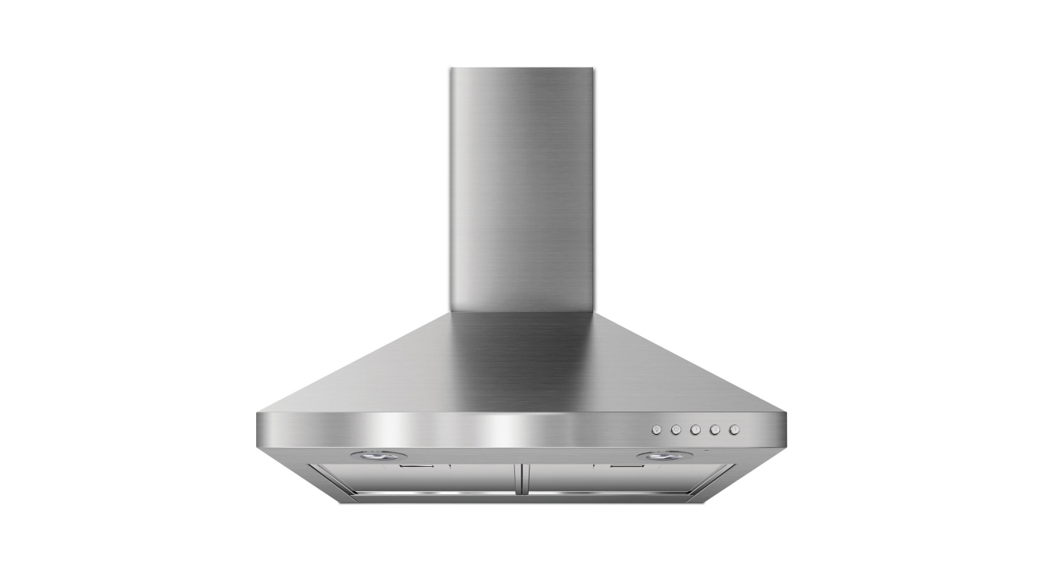30″ AND 36″ (76.2 AND 91.4 CM)WALL‑MOUNT CANOPY RANGEHOODInstallation Instructions and Use & Care GuideFor questions about features, operation/performance, parts, accessories, or service, call: 1-800-253-1301or visit our website at www.whirlpool.comIn Canada, call 1-800-807-6777 or visit our website at www.whirlpool.ca

IMPORTANT: READ AND SAVE THESE INSTRUCTIONS.FOR RESIDENTIAL USE ONLY.
RANGE HOOD SAFETY
Your safety and the safety of others are very important.We have provided many important safety messages in this manual and on your appliance. Always read and obey all safety messages. This is the safety alert symbol.This symbol alerts you to potential hazards that can kill or hurt you and others.All safety messages will follow the safety alert symbol and either the word “DANGER” or “WARNING.” These words mean:
This is the safety alert symbol.This symbol alerts you to potential hazards that can kill or hurt you and others.All safety messages will follow the safety alert symbol and either the word “DANGER” or “WARNING.” These words mean:![]() DANGER You can be killed or seriously injured if you don’t immediately follow instructions.
DANGER You can be killed or seriously injured if you don’t immediately follow instructions.![]()
![]()
![]()
IMPORTANT SAFETY INSTRUCTIONS
WARNING: TO REDUCE THE RISK OF FIRE, ELECTRIC SHOCK, OR INJURY TO PERSONS, OBSERVE THE FOLLOWING:
- Use this unit only in the manner intended by the If you have questions, contact the manufacturer.
- Before servicing or cleaning the unit, switch power off at the service panel and lock the service disconnecting means to prevent power from being switched on accidentally. When the service disconnecting means cannot be locked. securely fasten a prominent warning device, such as a tag, to the service panel.
- Installation work and electrical wiring must be done by a qualified person(s) in accordance with all applicable codes and standards, including fire-rated construction.
- Do not operate any fan with a damaged cord or plug. Discard fan or return to an authorized service facility for examination and/or repair.
- Sufficient air is needed for proper combustion and exhausting of gases through the flue (chimney) of fuel-burning equipment to prevent back-drafting. Follow the heating equipment manufacturer’s guidelines and safety standards such as those published by the National Fire Protection Association (NFPA), the American Society for Refrigeration and Air Conditioning Engineers (ASHRAE), and the local code authorities.
- When cutting or drilling into a wall or ceiling, do not damage electrical wiring and other hidden utilities.
- Ducted fans must always be vented outdoors.
CAUTION: For general ventilating use only. Do not use to exhaust hazardous or explosive materials and vapors.CAUTION: To reduce the risk of fire and to properly exhaust air, be sure to duct air outside – do not vent exhaust air into spaces within walls or ceilings, attics or into crawl spaces, or garages.WARNING: TO REDUCE THE RISK OF FIRE, USE ONLY METAL DUCTWORK.WARNING: TO REDUCE THE RISK OF A RANGE TOP GREASE FIRE:
- Never leave surface units unattended at high settings. Boilovers cause smoking and greasy spillovers that may Heat oils slowly on low or medium settings.
- Always turn hood ON when cooking at high heat or when flam being food (i.e. Crepes Suzette, Cherries Jubilee, Peppercorn Beef Flambe).
- Clean ventilating fans frequently. Grease should not be allowed to accumulate on the fan or filter.
- Use proper pan size. Always use cookware appropriate for the size of the surface element.
WARNING: TO REDUCE THE RISK OF INJURY TO PERSONS IN THE EVENT OF A RANGE TOP GREASE FIRE, OBSERVE THE FOLLOWING:”
- SMOTHER FLAMES with a close-fitting lid, cookie sheet, or metal tray, then turn off the burner. BE CAREFUL TO PREVENT BURNS. If the flames do not go out immediately, EVACUATE AND CALL THE FIRE
- NEVER PICK UP A FLAMING PAN – you may be burned.
- DO NOT USE WATER, including wet dishcloths or towels -a violent steam explosion will result.
- Use an extinguisher ONLY if:•You know you have a Class ABC extinguisher, and you already know how to operate it.•The fire is small and contained in the area where it•The fire department is being called.•You can fight the fire with your back to an exit.‘Based on “Kitchen Fire Safety Tips” published by NFPA.
- WARNING: To reduce the risk of fire or electrical shock, do not use this fan with any solid-state speed control
- This appliance is not intended for use by people (including children) whose physical, sensory, or mental capacities are different or impaired or who lack the necessary experience or knowledge/expertise to do so unless such persons are supervised or are trained to operate the appliance by a person who accepts responsibility for their safety.
READ AND SAVE THESE INSTRUCTIONS
INSTALLATION REQUIREMENTS
Tools and PartsGather the required tools and parts before starting installation. Read and follow the instructions provided with any tools listed here.Tools Needed
|
|
Parts Needed
- Home power supply cable 1
- /2″ (12.7 mm) UL listed or CSA approved strain relief
- 3 UL listed wire connectors
For Vented Installations, You Will Also Need:
- 1 wall or roof cap
- Metal vent system
For Non-Vented (Recirculating) Installations, You Will Also Need:
- Recirculation Kit for non-vented (recirculating) installations only. See the “Assistance or Service” section to order.
- 6″ (15.2 cm) diameter round metal vent duct – length required is determined by the ceiling height.
Parts SuppliedRemove parts from packages. Check that all parts are included.
- Hood canopy assembly with blower and LED lights installed
- Vent transition with back draft dampers installed
- Vent cover support bracket
- Metal grease filter(s)
- Mounting template
- 2-piece vent cover
- 2 – 2.9 x 6.5 mm screws (Phillips)
- 2 – 3.5 x 9.5 mm screws (Phillips)
- 6 – 5 x 45 mm mounting screws (#2 Phillips)
- 4 – 8 x 40 mm wall anchors (masonry)
Location Requirements
IMPORTANT: Observe all governing codes and ordinances.Have a qualified technician install the range hood. It is the installer’s responsibility to comply with installation clearances specified on the model/serial/rating plate. The model/serial/ rating plate is located behind the left filter on the rear wall of the vent hood.Canopy hood locations should be away from strong draft areas, such as windows, doors, and strong heating vents.Cabinet opening dimensions that are shown must be used.Given dimensions provide minimum clearance.This range hood is recommended for use with cooktops with a maximum total rating of 60,000 BTUs or less.A grounded electrical outlet is required. See “Electrical Requirements” section.The canopy hood is factory set for venting through the roof or wall. For non-vented (recirculating) installation, see “For non-vented (recirculating) installation only” in the “Connect Vent System” section.Recirculation Kit is available from your dealer or an authorized parts distributor. See the “Assistance or Service” section to order.All openings in the ceiling and wall where the canopy hood will be installed must be sealed.For Mobile Home InstallationsThe installation of this range hood must conform to the Manufactured Home Construction Safety Standards, Title 24 CFR, Part 328 (formerly the Federal Standard for Mobile Home Construction and Safety, Title 24, HUD, Part 280) or when such standard is not applicable, the standard for Manufactured Home Installation 1982 (Manufactured Home Sites, Communities and Setups) ANSI A225.1/NFPA 501A, or latest edition, or with local codes.Product Dimensions
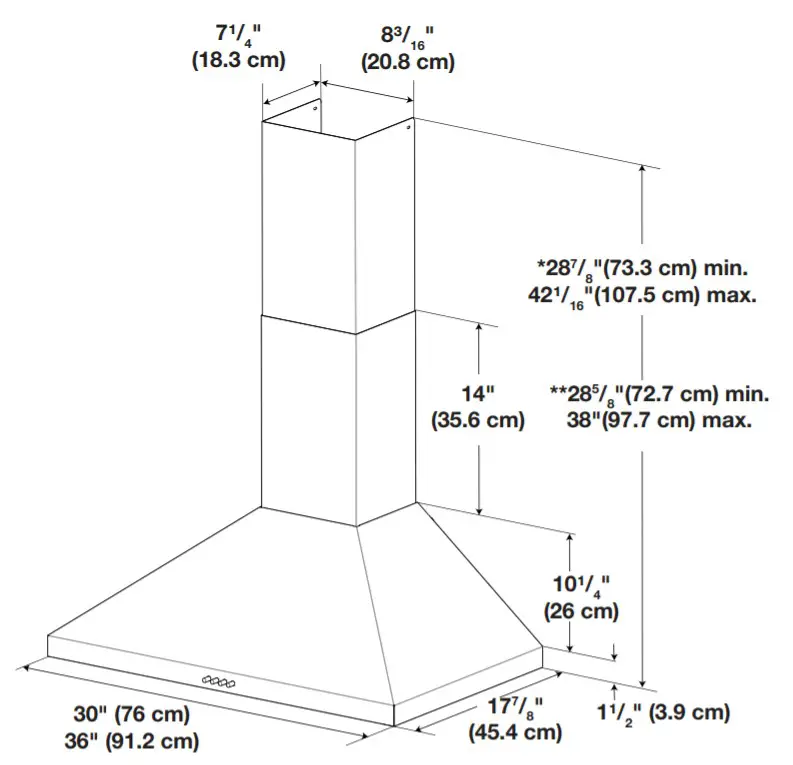

* For non-vented (recirculating) installations** For vented installations®†TORX and T20 are registered trademarks of Acument Intellectual Properties, LLC
Cabinet Dimensions


IMPORTANT:Minimum distance “X”: 24″ (61 cm) from the electric cooking surfaceMinimum distance “X”: 27″ (68.6 cm) from the gas cooking surfaceSuggested maximum distance “X”: 36″ (91.4 cm)The chimneys can be adjusted for different ceiling heights.See the following chart.Vented Installations
| Min. ceiling height | Max. ceiling height | |
| Electric cooking surface | 7′ 5″ (2.26 m) | 9′ 2″ (2.79 m) |
| Gas cooking surface | 7′ 8″ (2.34 m) | 9′ 2″ (2.79 m) |
| Non-Vented (Recirculating) Installations | ||
| Min. ceiling height | Max. ceiling height | |
| Electric cooking surface | 7′ 5″ (2.26 m) | 9′ 6″ (2.9 m) |
| Gas cooking surface | 7′ 8″ (2.34 m) | 9′ 6″ (2.9 m) |
NOTE: The range hood chimneys are adjustable and designed to meet the varying ceiling or soffit heights, depending on the distance “X” between the bottom of the range hood and the cooking surface. For higher ceilings, a Stainless Steel Chimney Extension Kit is available from your dealer or an authorized parts distributor. See the “Assistance or Service” section to order. The chimney extension replaces the upper chimney shipped with the range hood.
Venting Requirements (vented models only)
- The vent system must terminate to the outdoors except for non-vented (recirculating) installations.
- Do not terminate the vent system in an attic or other enclosed area.
- Do not use a 4″ (10.2 cm) laundry-type wall cap.
- Use metal vent only. A rigid metal vent is recommended.A plastic or metal foil vent is not recommended.
- The length of the vent system and the number of elbows should be kept to a minimum to provide efficient performance.
For the Most Efficient and Quiet Operation:
- Use no more than three 90° elbows.
- Make sure there is a minimum of 24″ (61 cm) of straight vent between the elbows if more than 1 elbow is used.
- Do not install 2 elbows together.
- Use clamps to seal all joints in the vent system.
- The vent system must have a damper. If the roof or wall cap has a damper, do not use the damper supplied with the range hood.
- Use caulking to seal the exterior wall or roof opening around the cap.
- The size of the vent should be uniform.
Cold Weather InstallationsAn additional back draft damper should be installed to minimize backward cold airflow and a thermal break should be installed to minimize conduction of outside temperatures as part of the vent system. The damper should be on the cold air side of the thermal break.The break should be as close as possible to where the vent system enters the heated portion of the house. zMakeup AirLocal building codes may require the use of makeup air systems when using ventilation systems greater than specified CFM ofair movement. The specified CFM varies from locale to locale.Consult your HVAC professional for specific requirements in your area.Venting MethodsThis canopy hood is factory set for venting through the roof or wall.A 6″ (15.2 cm) round vent system is needed for installation (not included). The hood exhaust opening is 6″ (15.2 cm) round.NOTE: Flexible vent is not recommended. A flexible vent creates backpressure and air turbulence that greatly reduces performance.The vent system can terminate either through the roof or wall.To vent through a wall, a 90° elbow is needed.Rear DischargeA 90° elbow may be installed immediately above the hood.For Non-Vented (Recirculating) InstallationsIf it is not possible to vent cooking fumes and vapors to the outside, the hood can be used in the non-vented (recirculating) version, fitting a charcoal filter and the deflector. Fumes and vapors are recycled through the top grille. See the “Assistance or Service” section for information on ordering.
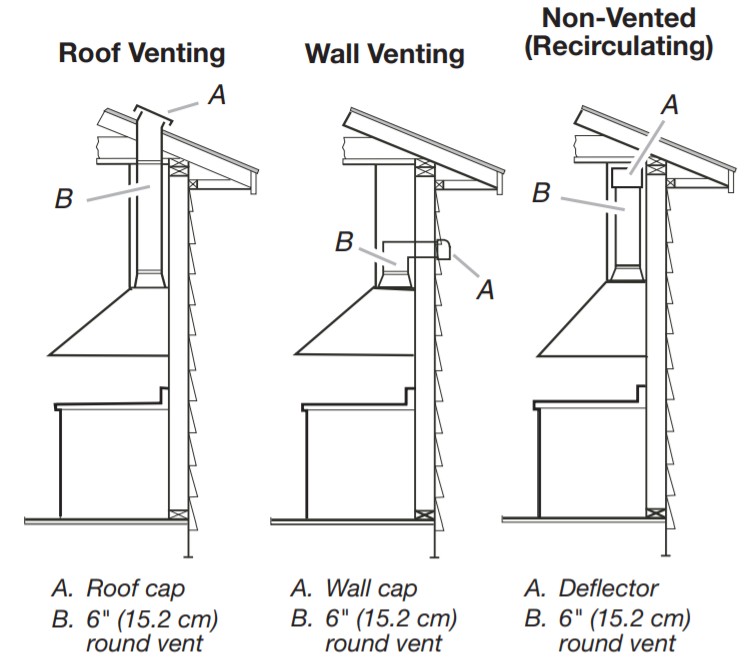

Calculating Vent System LengthTo calculate the length of the system you need, add the equivalent feet (meters) for each vent piece used in the system.
| Vent Piece | 6″ (15.2 cm) Round | |
| 45° elbow | 2.5 ft (0.8 m) | 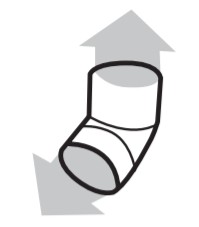  |
| 90° elbow | 5 ft (1.5 m) |   |
The maximum equivalent vent length is 35 ft (10.7 m).Example Vent System


The following example falls within the maximum recommended vent length of 35 ft (10.7 m).
| 1 – 90° Elbow | = 5 ft (1.5 m) |
| 1 – Wall cap | = 0 ft (0 m) |
| 8 ft (2.4 m) straight | = 8 ft (2.4 m) |
| Length of system | = 13 ft (3.9 m) |
INSTALLATION INSTRUCTIONS
Prepare Location
■ It is recommended that the vent system be installed before the hood is installed.■ Before making cutouts, make sure there is proper clearance within the ceiling or wall for the exhaust vent.■ Check your ceiling height and the hood height maximum before you select your hood.
- Disconnect power.
- Determine which venting method to use: roof, wall, or non-vented.
- Select a flat surface for assembling the range hood.Place covering over that surface.

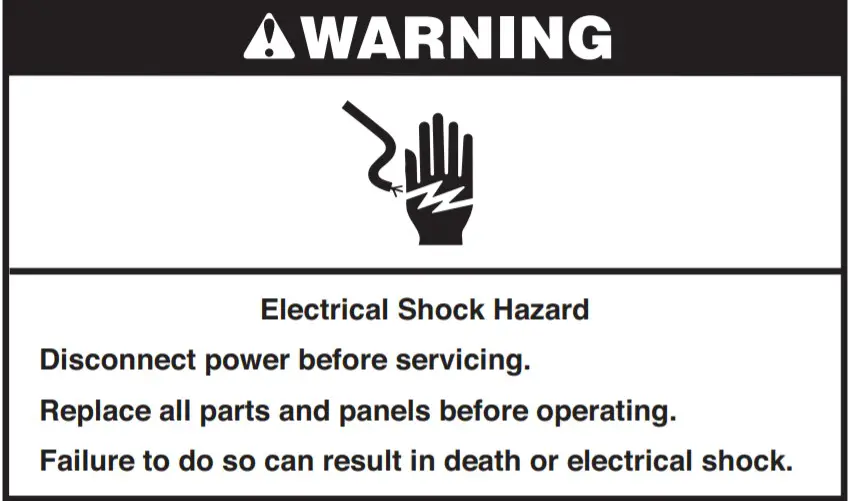
- Using 2 or more people, lift the range hood onto the covered surface.
- Remove the wood base from the range hood and dispose of it properly.
Range Hood Mounting Screws Installation
- Determine and mark the centerline on the wall where the canopy hood will be installed.
- Select a mounting height between a minimum of 24″ (61 cm) for an electric cooking surface, a minimum of 27″ (68.6 cm)for a gas cooking surface, and a suggested maximum of 36″ (91.4 cm) above the range to the bottom of the hood. Mark areference line on the wall.
- Tape template in place, aligning the template centerline and bottom of template with the hood bottom line and with the centerline marked on the wall.

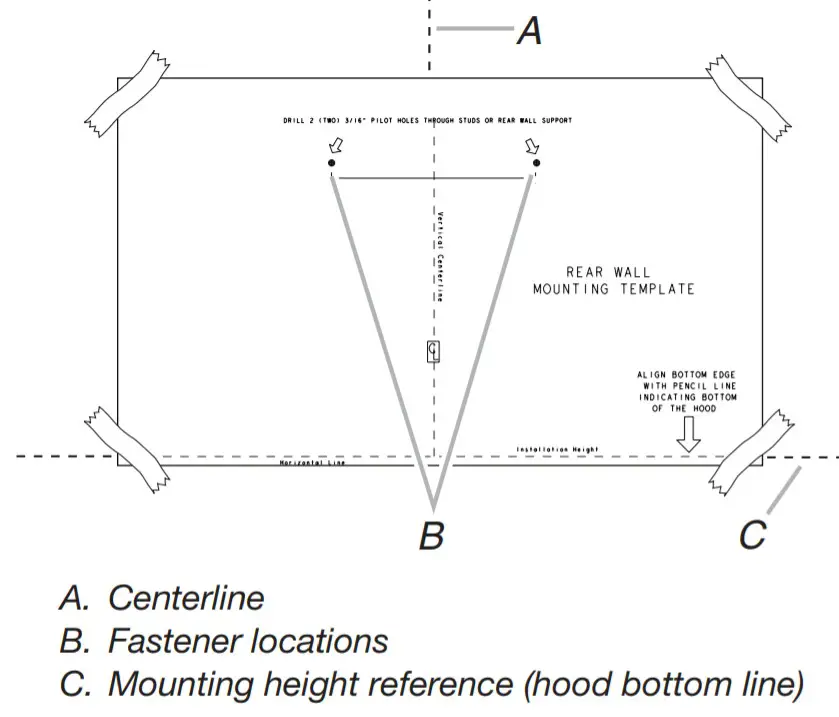
- Mark centers of the fastener locations through the template to the wall.IMPORTANT: All canopy mounting screws must be installed into the wood where possible. If there is no wood to screw into, additional wall framing supports may be required or use (4) 10 x 60 mm wall anchors and 5.4 x 75 mm screws (not included).Remove the template.
- For wood, drill 3/16″ (4.8 mm) pilot holes at all locations where screws are being installed into the wood.For wall anchors, drill 7/16″ (10 mm) holes at all locations where wall anchors are being used.
- For wood, install (2) 5 x 45 mm mounting screws. Leave a 1/4″ (6.4 mm) gap between the wall and the back of the screw head to slide the range hood into place.For wall anchors, install the 10 x 60 mm wall anchors and install the 5.4 x 75 mm screws into the wall anchors.Tighten until the wall anchors are secure. Back the screws out 1/4″ (6.4 mm).

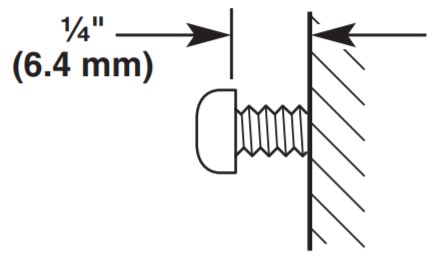
Vent Cover Support Bracket InstallationInstallations using telescoping upper and lower vent cover assembly
- Position vent cover bracket on the wall about 1/8″ (3 mm) away from the ceiling.
- Mark the hole locations.
- Drill (2) 3/8″ (9.5 mm) holes for 8 x 40 mm wall anchors and insert anchors flush with the wall.

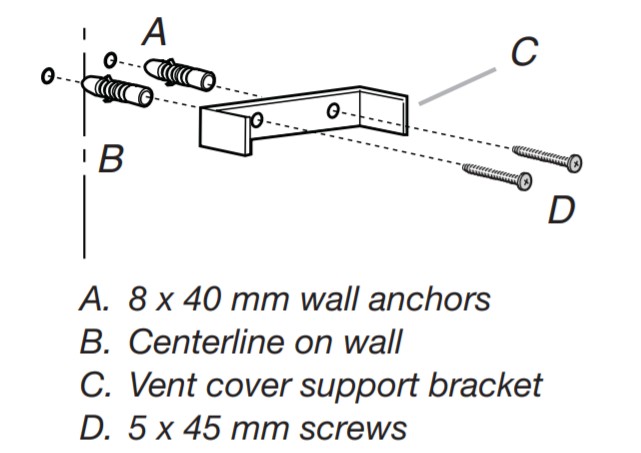
- Attach vent cover support bracket to the wall.
Complete Preparation
- Determine and make all necessary cuts in the wall for the vent system. Install the vent system before installing the hood. See the “Venting Requirements” section.
- Determine the required height for the home power supply cable and drill a 1 1/4″ (3.2 cm) hole at this location.
- Run the home power supply cable according to the NationalElectrical Code or CSA Standards and local codes and ordinances. There must be enough 1 /2″ conduit and wires from the fused disconnect (or circuit breaker) box to make the connection in the hood’s electrical terminal box.NOTE: Do not reconnect power until installation is complete.
- Use caulk to seal all openings.
Connect Vent System
- Install transition on top of hood (if removed for shipping) with (2) 3.5 x 9.5 mm sheet metal screws.

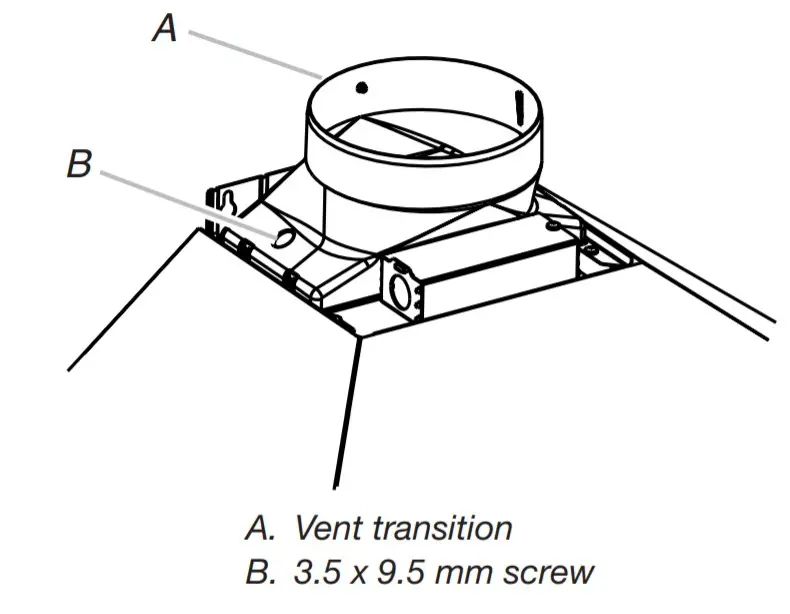
For vented installations only:
- Fit vent system over transition piece.
- Seal connection with clamps.
- Check that the backdraft damper works properly.
Install Range HoodNOTE: Remove protective film from the range hood and metal filters.
- Using 2 or more people, hang the range hood on 2 mounting screws through the mounting slots on the back of the hood.

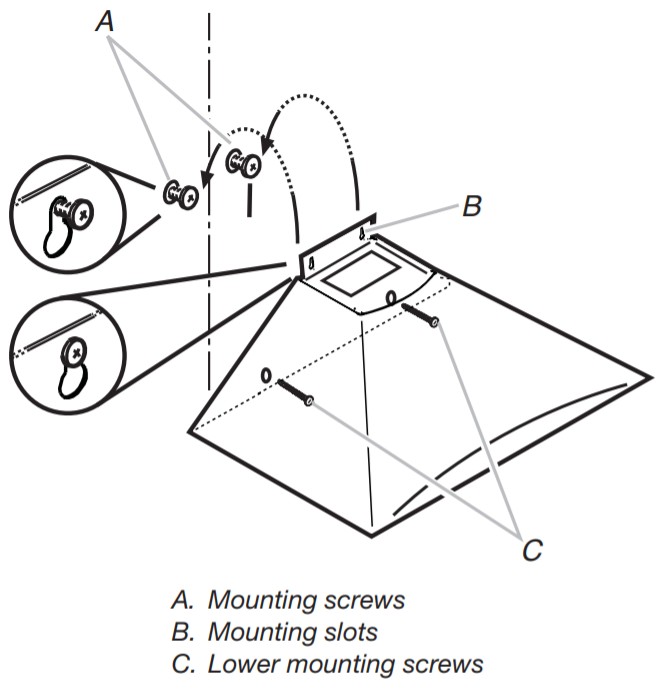
- Remove the grease filter. See “Range Hood Care” section.
- Level the range hood and tighten the upper mounting screws.
- Install (2) 5 x 45 mm lower mounting screws and tighten.Use the optional wall anchors if needed.
For non-vented (recirculating) installation only:
- Assemble the air deflector with the duct cover bracket with 2 assembly screws were provided with the Recirculation Kit.

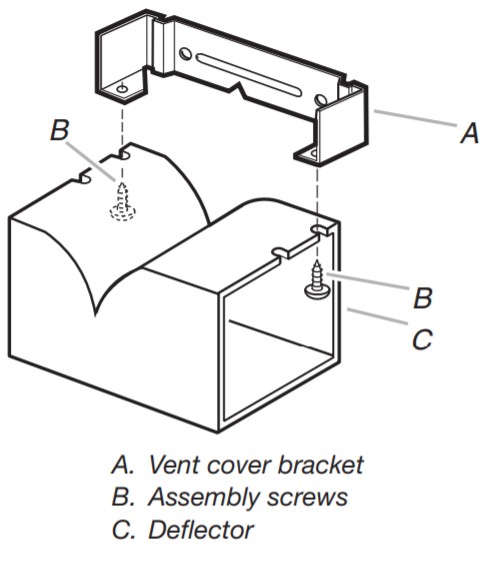
- Measure from the bottom of the air deflector to the bottom of the hood outlet.

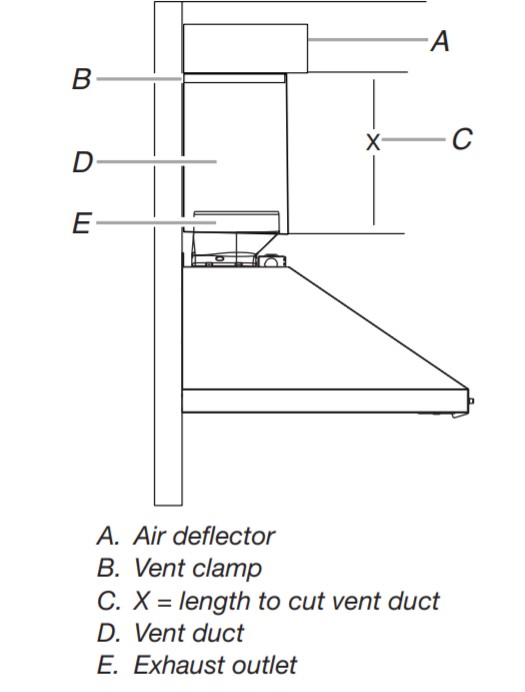
- Cut the duct to the measured size “X.”
- Remove the air deflector.
- Slide the duct onto the bottom of the air deflector.
- Place the assembled air deflector and duct over the exhaust outlet from the hood.
- Reassemble the air deflector to the duct cover bracket with the 2 assembly screws.
- Seal connections with vent clamps.
Make Electrical Connection
![]()
![]()
![]()
- Disconnect power.
- Remove terminal box cover.
- Remove the knockout in the terminal box and install a UL-listed or CSA-approved 1/2″ strain relief.


- Run home power supply cable through strain relief into terminal box.


- Use UL listed wire connectors and connect black wires (E) together.
- Use UL listed wire connectors and connect white wires (C) together.



- Connect green (or bare) ground wire from home power supply to yellow-green ground wire (F) in terminal box using UL listed wire connectors.
- Tighten strain relief screw.
- Install terminal box cover.
- Check that all light bulbs are secure in their sockets.
- Reconnect power.
Install Vent CoversNOTE: Remove protective film from the vent covers.
- When using both upper and lower vent covers, push the lower cover down onto the hood and lift the upper cover to the ceiling and install with (2) 2.9 x 6.5 mm screws.


NOTE: For vented installations, the upper vent cover may be reversed to hide slots.
Complete Installation
- For non-vented (recirculating) installations only, install charcoal filters over the grease filters, using the clips provided in the kit. See the “Range Hood Care” section.
- Install metal filters. See the “Range Hood Care” section.
- Check the operation of the range hood blower and light.See the “Range Hood Use” section.NOTE: To get the most efficient use from your new range hood, read the “Range Hood Use” section.
RANGE HOOD USE
The range hood is designed to remove smoke, cooking vapors, and odors from the cooktop area. For best results, start the hood before cooking and allow it to operate several minutes after the cooking is complete to clear all smoke and odors from the kitchen. The hood controls are located on the front side of the canopy.
Range Hood Controls
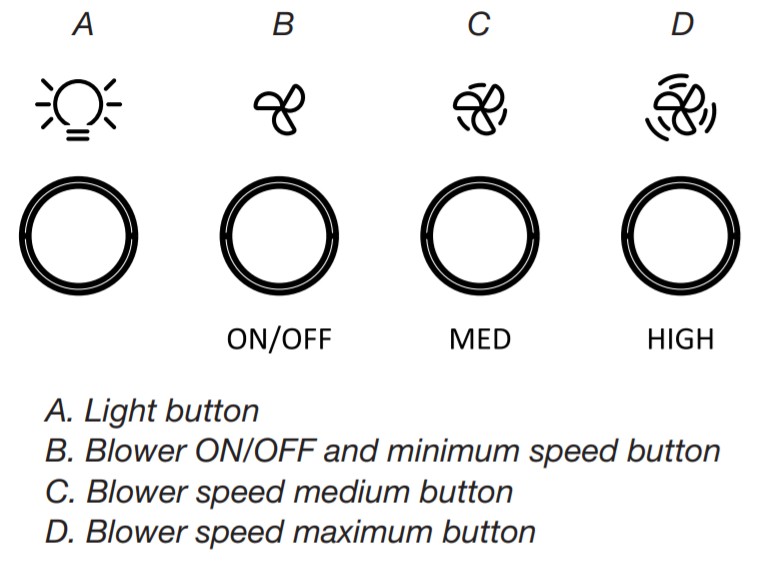

Operating the lightThe ![]()
![]()
RANGE HOOD CARE
CleaningIMPORTANT: Clean the hood and grease filters frequently according to the following instructions. Replace grease filters before operating hood.Exterior SurfacesTo avoid damage to the exterior surface, do not use steel wool or soap-filled scouring pads.Always wipe dry to avoid watermarks.Cleaning Method:
- Liquid detergent soap and water, or all-purpose cleaner
- Wipe with a damp soft cloth or non-abrasive sponge, and then rinse with clean water and wipe dry.
Metal Grease Filter
- Remove the filter by pulling the spring release handle and then pulling down the filter.


- Wash metal filter as needed in the dishwasher or hot detergent solution.
- Reinstall the filter by making sure the spring release handles are toward the front. Insert aluminum filter into the upper track.
- Push-in spring release handle.
- Push up on the metal filter and release the handle to latch into place.
- Repeat steps 1-5 for the other filter.
Non-Vented (recirculating) Installation FiltersThe charcoal filter is not washable. It should last up to 6 months with normal use. Replace with Charcoal Filter Kit. See the“Assistance or Service” section for information on ordering.
To replace the charcoal filter:
- Remove metal grease filter from the range hood. See “Metal Grease Filter” in this section.
- Bend spring clips away from the metal grease filter.

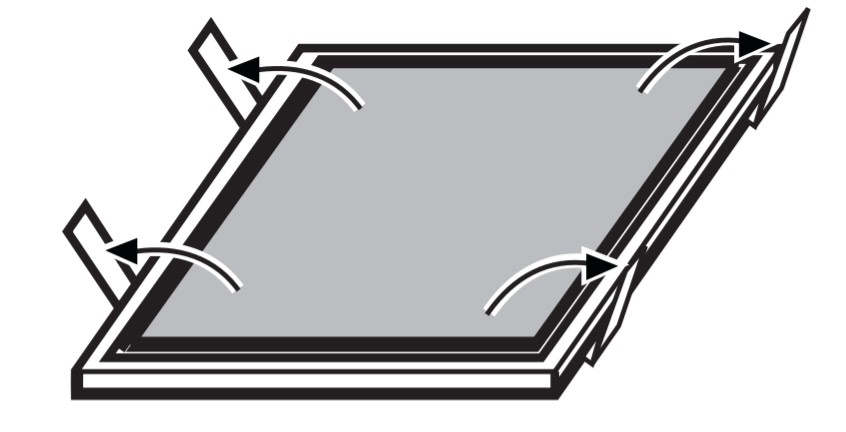
- Place charcoal filter into the top side of the metal filter.
- Bend spring clips back into place to secure the charcoal filter to the metal filter.

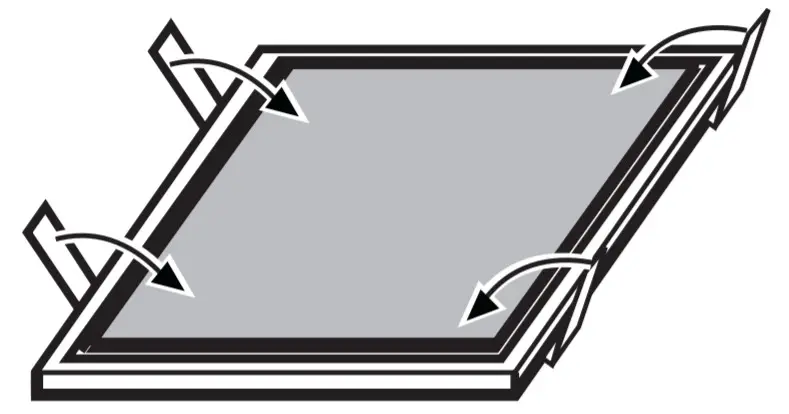
- Replace the metal grease filter. See “Metal Grease Filter” in this section.
Replacing a LED LampThe LED lights are replaceable by a service technician only.See the “Warranty” section for service contact information.
WIRING DIAGRAM
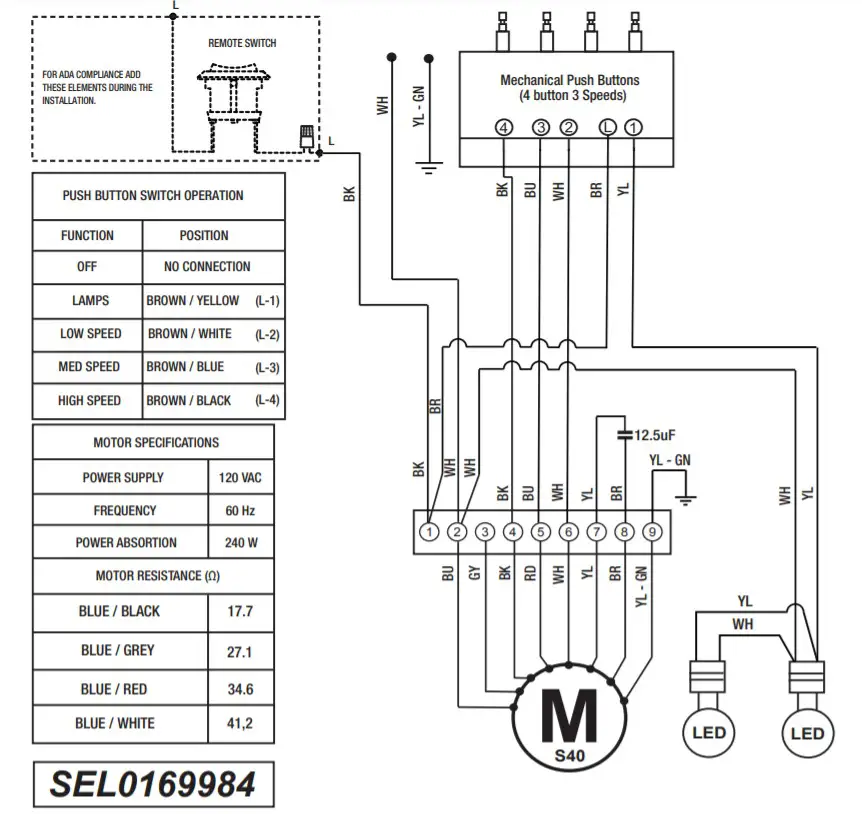

ASSISTANCE OR SERVICE
If you need servicePlease refer to the warranty page in this manual.If you need replacement partsIf you need to order replacement parts, we recommend that you use only factory specified parts. Factory specified parts will fit right and work right because they are made with the same precision used to build every new appliance.To locate factory-specified replacement parts in your area, call the following customer assistance telephone number or your nearest designated service center.In the U.S.A.Call the Whirlpool Customer eXperience Center toll-free: 1-800-253-1301 or visit our website at www.whirlpool.com.Our consultants provide assistance with:
- Scheduling of service. Whirlpool designated service technicians are trained to fulfill the product warranty and provide after-warranty service anywhere in the United States.
- Features and specifications on our full line of appliances.
- Referrals to local dealers.
- Installation information.
- Use and maintenance procedures.
- Accessory and repair parts sales.
- Specialized customer assistance (Spanish speaking, hearing impaired, limited vision, etc.).
For further assistanceIf you need further assistance, you can write to WhirlpoolA corporation with any questions or concerns at:Whirlpool Brand Home AppliancesCustomer Experience Center553 Benson RoadBenton Harbor, MI 49022-2692Please include a daytime phone number in your correspondence.In CanadaCall the Whirlpool Canada Customer eXperience Centre toll-free: 1-800-807-6777, or visit our website at www.whirlpool.ca.Our Consultants Provide Assistance With:
- Scheduling of Service. Whirlpool designated service technicians are trained to fulfill the product warranty and provide after-warranty service anywhere in Canada.
- Features and specifications on our full line of appliances.
- Referrals to local dealers.
- Use and maintenance procedures.
- Accessory and repair parts sales.
For Further AssistanceIf you need further assistance, you can write to WhirlpoolCanada with any questions or concerns at:Whirlpool Brand Home AppliancesCustomer eXperience Centre200 – 6750 Century Ave.Mississauga, Ontario L5N 0B7Please include a daytime phone number in your correspondence.AccessoriesRecirculation Kit(for non-vented installations only)Order Part Number W11548459Charcoal Filter Kit(for non-vented installations only)Order Part Number W11548461Chimney Extension KitOrder Part Number EXTKIT18FS6″ (15.2 cm) Makeup Air Kit(consult local building codes)Order Part Number W10446915Range Hood Power Cord Kit(consult local building codes)Order Part Number W10613691
W11549255A®/™ ©2021 Whirlpool.Used under license in Canada.All rights reserved.
References
[xyz-ips snippet=”download-snippet”]

